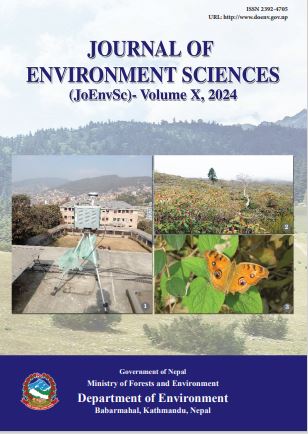Potential Sources and Seasonal Transport Pathways of Organic and Elemental Carbon in the Lesser Himalayan Zone of Central Nepal
DOI:
https://doi.org/10.3126/jes.v10i1.66914Keywords:
Back trajectory, EC, OC, Sources, TSPAbstract
Carbonaceous aerosols consist of a bulky but highly variable mass of atmospheric aerosols, mostly comprised of Organic Carbon (OC) and Elemental Carbon (EC). OC is emitted directly into the atmosphere or formed secondarily from the photo-oxidation process that condensed semi- or non-volatile compounds and polymerizes organic species in the atmosphere. EC mainly originate from incomplete combustion of biomass and fossil fuels, and have an instantaneous consequence on radiative forcing effect on regional climate. This study was carried out in Dhulikhel Municipality to determine the potential sources and seasonal pathways of carbonaceous aerosols (OC and EC) transporting to receptor site by measurement and modeling approaches. The 72 samples were collected (24-hrs) over a year (January-December 2018) using a medium volume air sampler. The minimum and maximum concentrations of Total Suspended Particulate ranged from 38.00 µg/m3 to 442.45 µg/m3. The annual average OC/EC ratio 2.73 ±0.84 indicates the presence of Secondary Organic Aerosols and other major sources of carbonaceous aerosols including biomass burning, vehicular emission, and coal combustion. Hybrid-Single-Particle Lagrangian Integrated Trajectory (HYSPLIT) air-mass back trajectory analysis integrated with meteorological fields was used to identify the potential sources and their atmospheric transport pathway. The back trajectories of the 96-hrs period were plotted at 6-hrs intervals starting from a single observation location at Dhulikhel. The back trajectories were clustered into four distinct seasons to trace temporal variation in the atmospheric aerosols during the study period. The results from the HYSPLIT revealed that the sources of particulate pollutants reaching Dhulikhel are local as well as of regional origin and are mostly transported from the Middle East and South Asian countries like India, Pakistan, Bangladesh, Iran, Saudi Arabia, and Egypt




